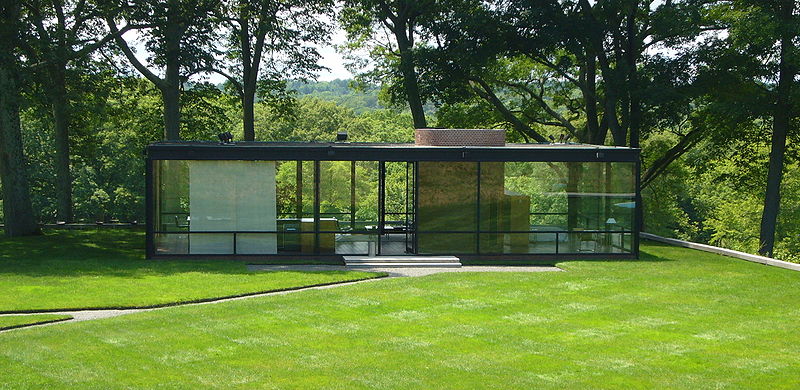Philip Cortelyou Johnson was an influential 20th century American architect. Johnson was responsible for many of the buildings that line the iconic skylines of several major cities. Johnson’s work on his own home, the Glass House, and the AT&T Corporate Headquarters in New York City is very indicative and demonstrative of Johnson’s architectural evolution. Johnson is considered to be the forerunner in the introduction of two major architectural movements in the United States; the international style and postmodernism.
Philip C. Johnson was born on July 8, 1906 in Cleveland, Ohio. 1 Johnson went on to study classics at Harvard College, it wasn’t until later in his life did Johnson become interested in architecture. In fact, it wasn’t until Johnson was 36 did he ever design his first piece of building. Prior to becoming an architect, Johnson worked as a museum director and curator, often championing the works of modern architects like Le Corbusier and Mies van de Rohe. 2 Johnson was greatly interested in the minimalist style of these major architects and designers. No longer content with just curating the works of these artists, Johnson returned to Harvard where he attended design school and studied architecture under the instruction of Marcel Breuer. 3

Artistically, Johnson was very interested in the international style and the teachings of the Bauhaus from overseas. The international style stressed the use of modern materials in structures that focused more on the form and function of the building rather than the use elaborate ornamentation. 4 Many of Johnson’s early works implemented very stark and minimalist designs; Johnson’s own home in New Canaan, Connecticut, The Glass House, greatly demonstrated his interest in the international style. 5 As seen in Figure 1, Johnson’s sparing and stark use of glass and steel in his Glass House clearly show the influences of the international style on his design aesthetic. There is minimal, if any, ornamentation and the materials used for the structural elements are all extremely industrial.
Perhaps it is only through the examination of the AT&T Building can Johnson’s breakthrough to postmodernism movement be seen. In collaboration with John Burgee, Johnson was commissioned to design the AT&T Corporate Headquarters (now the Sony Building) in 1978. 6 Located in the heart of Manhattan, the AT&T Building possesses postmodern elements and is reminiscent of historic styles. Rather than reject ornamentation, the AT&T Building is capped with a very dramatic “Chippendale” top that is purely for aesthetic purposes 7 As seen in Figure 2, the materials on the facade are also not indicative of its internal structure or configuration at all, another divergence from the constructional transparency of the international style.

Although Johnson’s career in architecture began later than many other prominent architects, his contributions to modern architecture are undeniable. He received many awards, such as the Pritzker Architecture Prize for lifetime achievement and the Gold Medal from the American Institute of Architects, which recognized his clear benefactions to the development of modern architecture and urban landscapes. 8 After a lifetime of incredibly influential work, at the age of 98, Philip C. Johnson passed away on January 25, 2005. 9
– JX
Figure 1: The Glass House (1949), New Canaan, CT. Philip C. Johnson. Photographer: Staib, Wikimedia Commons. Link. (Accessed November 20, 2015)
Figure 2: AT&T Corporate Headquarters (1984), New York City, NY. Philip C. Johnson and John Burgee. Photographer: David Shankbone, Wikimedia Commons. Link. (Accessed November 20, 2015)
Notes:
- “Biography: Philip Johnson.” The Pritzker Architecture Prize. Accessed November 20, 2015. ↩
- Ibid. ↩
- “About Philip Johnson.” PBS. January 7, 2003. Accessed November 19, 2015. ↩
- “Amon Carter Museum of American Art.” Philip Johnson Biography. Accessed November 19, 2015. ↩
- Ibid. ↩
- “Biography: Philip Johnson, Dean of American Architects.” Academy of Achievement. Accessed November 19, 2015. ↩
- Martinson, Tom. “Postmodernism.” In The Atlas of American Architecture: 2000 Years of Architecture, City Planning, Landscape Architecture and Civil Engineering, 251. New York, New York: Rizzoli International Publications, 2009. ↩
- “Biography: Philip Johnson, Dean of American Architects.” Accessed November 19, 2015. ↩
- “Amon Carter Museum of American Art.” Accessed November 19, 2015. ↩
